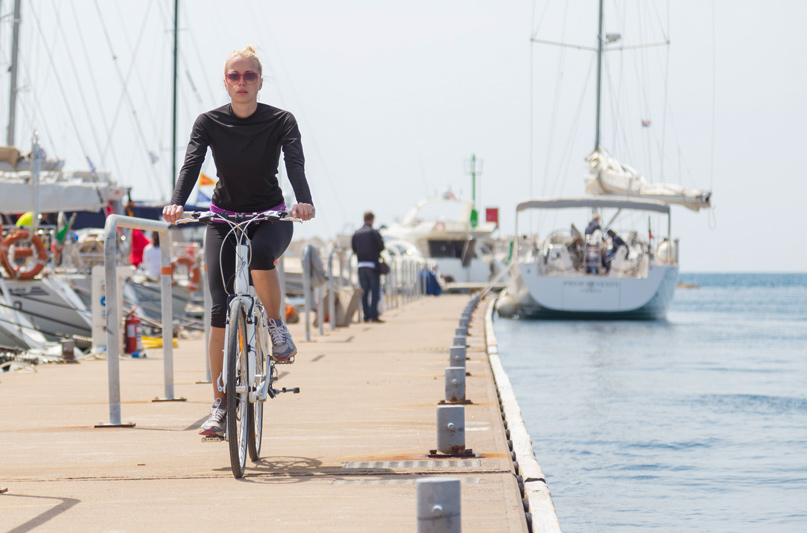No, this headline isn’t the latest summer blockbuster. Rather, as the squeeze gets tighter on the Seattle and Puget Sound area, the pressure to accommodate various special interests weighs ever heavier on elected officials. Examples of local land use that relate to boating include the annual Seattle Boat Show, the zoning around water-dependent shoreline interests, and how liveaboards are regulated by the city of Seattle. It’s an endless array of the whack-a-mole game from Chuck E. Cheese, except it’s not very fun and there’s no pizza.
Unfortunately, it’s easy for candidates and lawmakers to look past the bedrocks of our area like working waterfronts–which includes marinas and boatyards, for the bright, shiny, new groups that are clamoring for more. Enter the current conflict of bike vs. boat.
It’s worth noting that the opposition is not always biking-advocacy groups. Similar stalemates can occur between environmental organizations and maritime interests. For example, this situation has played out in Tacoma where marine groups support the Liquified Natural Gas facility in Tacoma and an environmental group does not.

In the not too distant past, bikes versus boats issues popped up in the Westlake area of Seattle (i.e. western part of Lake Union). To unwrap the Westlake example a little more, there was insurmountable momentum to appease bike interests. The previous two mayors and their SDOT directors placed the bike special interest group over the area’s maritime business community. I did not want to believe this, but after serving on the mayor’s Design Advisory Committee to flesh out this cycle track, I can tell you that they were not just that into us. For non-boaters, this area was just a 1.2-mile parking lot that had a Wild West look and feel. For the maritime world, an economic impact study (funded by the Westlake Stakeholders Group) found that 1,200 boats and 3,464 total jobs called that area home. During the 16 months of cycle track design, both sides (me included) spent too much time talking past each other.
Sadly, a cemented view of each group results in a ruthless Andrew Carnegie style of lobbying replacing the “go along, to get along” Dale Carnegie approach, which I prefer. Instead of looking for creative solutions to age-old issues (like a shrinking waterfront that is constantly being developed), positions harden into a “we are right, they are wrong” pitched battle. If not careful, a “Why are they out to get us?” cynicism can creep in.
There’s a term that describes this “I’m right, you’re wrong” paradigm. Hardened views are described as “rock logic” and softer, more flowing connections are portrayed as “water logic.” Water logic acknowledges that both parties are right, but each conclusion is based on a particular aspect of the situation.
Let’s put this water-logic lens on the Missing Link section of the Burke Gilman Trail (the freight corridor of Ballard along Shilshole Avenue and the Ship Canal). Bicyclists have coveted this area as the last section of the Burke Gilman for decades. What’s not to like? They want to get downtown in a jiffy and return home safely. Finally completing this section would justify the hundreds of thousands of court costs and thousands of hours of advocacy. It’s the quintessential trap of sunk costs.
On the other side of the argument are the marine industrial businesses and maritime boatyards like CSR Marine, Pacific Fishermen Shipyard, and Ballard Sand and Gravel that simply want to provide parking for their customers and access for the trucks coming and going that are part and parcel of a working waterfront.
Just look at what’s at stake on the water’s edge:
- The owners of Dantrawl moved their fishing net business away from Shilshole Ave because of safety concerns with the conflict of their huge trucks and cyclists.
- There are only four fixed fueling facilities in our region, many of which serve the area’s recreational fleet. Two are along Shilshole Avenue: Ballard Oil and Covich Williams with fueling trucks coming and going all day every day.
- CSR Marine employs 45 workers who use free 24-hour parking spaces on the site. Where else will these workers park in an already impacted parking situation?
Getting to where my tendencies lie, however, it is to point out a third way, a breakthrough, a water-logic leap that was scoffed at during the Westlake Cycle Track proceedings. It’s a called a high line and it is picking up steam as well as it should. In fact, upstart Seattle City Council candidate Heidi Wills, a working mom and business owner who has prioritized maritime interests in her current campaign (and someone I’m supporting for Seattle City Council), is looking to bring both sides together around common interests (both sides want security and safety) with a nod towards an elevated path to accommodate both groups.
At this early part of her campaign, why wouldn’t both camps embrace “I’m intrigued, I want to learn more” mindset. This is the beauty of these series of conversations we call politics. I say, let’s like it until we are told otherwise. What can you do? Check out and like “Ballard High Line” (facebook.com/BallardHighLine) on Facebook. Look into Water Logic in your own life (waterlogic.com). When bicycle interests look to assert themselves, keep in mind that they are interested in the same thing you are at the most fundamental level: safety and security. We can get there together.